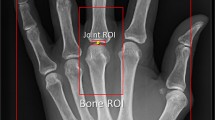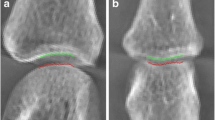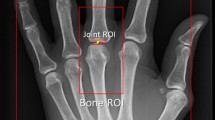Abstract
The joint space difference index (JSDI) is a newly developed radiographic index which can quantitatively assess joint space narrowing progression of rheumatoid arthritis (RA) patients by using an image subtraction method on a computer. The aim of this study was to investigate the reliability of this method by non-experts utilizing RA image evaluation. Four non-experts assessed JSDI for radiographic images of 510 metacarpophalangeal joints from 51 RA patients twice with an interval of more than 2 weeks. Two rheumatologists and one radiologist as well as the four non-experts examined the joints by using the Sharp–van der Heijde Scoring (SHS) method. The radiologist and four non-experts repeated the scoring with an interval of more than 2 weeks. We calculated intra-/inter-observer reliability using the intra-class correlation coefficients (ICC) for JSDI and SHS scoring, respectively. The intra-/inter-observer reliabilities for the computer-based method were almost perfect (inter-observer ICC, 0.966–0.983; intra-observer ICC, 0.954–0.996). Contrary to this, intra-/inter-observer reliability for SHS by experts was moderate to almost perfect (inter-observer ICC, 0.556–0.849; intra-observer ICC, 0.589–0.839). The results suggest that our computer-based method has high reliability to detect finger joint space narrowing progression in RA patients.


Similar content being viewed by others
References
van der Heijde DM (2000) Radiographic imaging: the “gold standard” for assessment of disease progression in rheumatoid arthritis. Rheumatology (Oxford) 39(Suppl 1):9–16. doi:10.1093/oxfordjournals.rheumatology.a031496
Plant MJ, Jones PW, Saklatvala J et al (1998) Patterns of radiological progression in early rheumatoid arthritis: results of an 8 year prospective study. J Rheumatol 25:417–426
Scott DL, Symmons DP, Coulton BL, Popert AJ (1987) Long-term outcome of treating rheumatoid arthritis: results after 20 years. Lancet 1(8542):1108–1111
Dias EM, Lukas C, Landewé R et al (2008) Reliability and sensitivity to change of the simple erosion narrowing score compared with the Sharp–van der Heijde method for scoring radiographs in rheumatoid arthritis. Ann Rheum Dis 67:375–379. doi:10.1136/ard.2007.072785
Sharp JT, Lidsky MD, Collins LC, Moreland J (1971) Methods of scoring the progression of radiologic changes in rheumatoid arthritis. Correlation of radiologic, clinical and laboratory abnormalities. Arthritis Rheum 14:706–720
van der Heijde D (2004) Quantification of radiological damage in inflammatory arthritis: rheumatoid arthritis, psoriatic arthritis and ankylosing spondylitis. Best Pract Res Clin Rheumatol 18:847–860. doi:10.1016/j.berh.2004.05.007
van Der Heijde D, Boonen A, Boers M et al (1999) Reading radiographs in chronological order, in pairs or as single films has important implications for the discriminative power of rheumatoid arthritis clinical trials. Rheumatology (Oxford) 38:1213–1220. doi:10.1093/rheumatology/38.12.1213
Sharp JT, Wolfe F, Lassere M et al (2004) Variability of precision in scoring radiographic abnormalities in rheumatoid arthritis by experienced readers. J Rheumatol 31:1062–1072
James MF, Heald G, Shorter JH, Turner RA (1995) Joint space measurement in hand radiographs using computerized image analysis. Arthritis Rheum 38:891–901
Higgs JB, Smith D, Des Rosier KF, Charlesworth RW (1996) Quantitative measurement of erosion growth and joint space loss in rheumatoid arthritis hand radiographs. J Rheumatol 23:265–272
Böttcher J, Pfeil A, Rosholm A et al (2006) Computerized quantification of joint space narrowing and periarticular demineralization in patients with rheumatoid arthritis based on digital x-ray radiogrammetry. Invest Radiol 41:36–44
Finckh A, de Pablo P, Katz JN et al (2006) Performance of an automated computer-based scoring method to assess joint space narrowing in rheumatoid arthritis: a longitudinal study. Arthritis Rheum 54:1444–1450. doi:10.1002/art.21802
Pfeil A, Renz DM, Hansch A et al (2013) The usefulness of computer-aided joint space analysis in the assessment of rheumatoid arthritis. Joint Bone Spine 80:380–385. doi:10.1016/j.jbspin.2012.10.022
Huo Y, Vincken KL, Van Der Heijde D et al (2016) Automatic quantification of radiographic finger joint space width of patients with early rheumatoid arthritis. IEEE Trans Biomed Eng 63:2177–2186
Ichikawa S, Kamishima T, Sutherland K et al (2015) Radiographic quantifications of joint space narrowing progression by computer-based approach using temporal subtraction in rheumatoid wrist. Br J Radiol. doi:10.1259/bjr.20150403
Ichikawa S, Kamishima T, Sutherland K et al (2016) Performance of computer-based analysis using temporal subtraction to assess joint space narrowing progression in rheumatoid patients. Rheumatol Int 36:101–108. doi:10.1007/s00296-015-3349-3
Bartlett JW, Frost C (2008) Reliability, repeatability and reproducibility: analysis of measurement errors in continuous variables. Ultrasound Obstet Gynecol 31:466–475. doi:10.1002/uog.5256
Association WM (1964) WMA declaration of Helsinki—ethical principles for medical research involving human subjects. 1–8. doi: 10.1017/CBO9781107415324.004
van der Heijde DM (1996) Plain X-rays in rheumatoid arthritis: overview of scoring methods, their reliability and applicability. Baillieres Clin Rheumatol 10:435–453. doi:10.1016/S0950-3579(96)80043-4
Landis JR, Koch GG (1977) The measurement of observer agreement for categorical data. Biometrics 33:159–174
Boini S, Guillemin F (2001) Radiographic scoring methods as outcome measures in rheumatoid arthritis: properties and advantages. Ann Rheum Dis 60:817–827
Larsen A, Dale K, Eek M (1977) Radiographic evaluation of rheumatoid arthritis and related conditions by standard reference films. Acta Radiol Diagn (Stockh) 18:481–491
Author information
Authors and Affiliations
Corresponding author
Ethics declarations
Conflict of interest
The authors declare no conflict of interest.
Ethical approval
All procedures performed in studies involving human participants were in accordance with the ethical standards of the institutional and/or national research committee and with the 1964 Helsinki Declaration and its later amendments or comparable ethical standards.
Informed consent
Informed consent was obtained from all individual participants included in the study.
Rights and permissions
About this article
Cite this article
Hatano, K., Kamishima, T., Sutherland, K. et al. A reliability study using computer-based analysis of finger joint space narrowing in rheumatoid arthritis patients. Rheumatol Int 37, 189–195 (2017). https://doi.org/10.1007/s00296-016-3588-y
Received:
Accepted:
Published:
Issue Date:
DOI: https://doi.org/10.1007/s00296-016-3588-y




